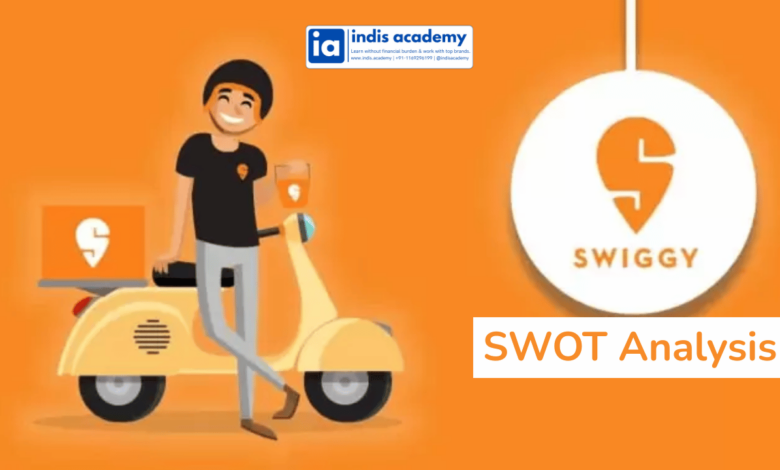Complete SWOT Analysis of Swiggy – India’s Leading Food Delivery Service

Swiggy has been at the forefront of the Indian food delivery revolution, transforming how Indians order food and experience convenience.
What started as a simple food delivery service in Bangalore in 2014 has now grown into India’s leading food-tech company, with operations in over 500 cities.
Swiggy’s innovative approach has made food delivery accessible to millions of customers across the country, contributing to the rise of the online food delivery market.
Swiggy’s impact is not limited to just food delivery; it has expanded into grocery delivery with Instamart, and launched cloud kitchens, diversifying its revenue streams and positioning itself as a leader in hyperlocal services.
Despite facing fierce competition and regulatory challenges, Swiggy continues to grow, driven by its commitment to speed, convenience, and quality service.
In this article, we will explore Swiggy’s Strengths, Weaknesses, Opportunities, and Threats (SWOT analysis).
By examining these elements, we can better understand how Swiggy continues to dominate the Indian food delivery market and how it plans to overcome challenges in a competitive landscape.
This analysis provides valuable insights into the evolving food-tech industry, consumer behavior, and the company’s strategic positioning.
Learn AI & Digital Marketing,
Pay Fees After Placement
- ✅ Minimal Admission Fees
- ✅ No Loan or Income Sharing Agreement
- ✅ 100% Placement Support
- ✅ ISO & Govt Registered Certificate
- ✅ Practical 3+1 Months Duration
Get a free counseling call. We’ll guide you through learning, certification, and job placement.
Request a Free Call Back
Takes less than a minute.
Company Overview – About Swiggy
Swiggy, founded in 2014 by Sriharsha Majety, Nandan Reddy, and Rahul Jaimini, has rapidly grown into India’s leading food delivery service.
Headquartered in Bangalore, Swiggy initially set out with a mission to make food delivery simple, ensuring fast and reliable service to consumers in urban areas.
Since its inception, Swiggy has expanded its services and now operates in over 500 cities across India, providing a wide range of food delivery services, grocery delivery (Instamart), and cloud kitchens.
Swiggy’s main offering is its food delivery platform, which connects customers to a network of over 160,000 restaurants.
The company uses its logistics infrastructure to provide consumers with timely delivery from restaurants, ranging from local eateries to premium dining establishments.
The service is available through Swiggy’s user-friendly mobile app, which facilitates easy order placement, real-time tracking, and customized recommendations.
In addition to food delivery, Swiggy has diversified its business model with Instamart, which provides grocery delivery, and Swiggy Access, a program to support cloud kitchens and restaurant partners.
These services further broaden Swiggy’s customer base and increase its revenue streams.
Swiggy’s commitment to speed, convenience, and quality service has helped it capture a significant share of India’s growing food-tech market, and it continues to innovate to meet the demands of an increasingly digital consumer base.
What is SWOT Analysis?
A SWOT analysis is a strategic tool used to evaluate a company’s current market position and identify internal and external factors that influence its performance.
The SWOT framework helps businesses assess their Strengths, Weaknesses, Opportunities, and Threats, providing valuable insights into how they can capitalize on opportunities and mitigate potential risks.
- S – Strengths: The internal factors that give the company a competitive advantage in the market. These could include brand reputation, technology, financial stability, or customer loyalty.
- W – Weaknesses: The internal challenges or limitations that could hinder the company’s growth. These might be resource limitations, operational inefficiencies, or areas where competitors have an edge.
- O – Opportunities: External factors or trends that the company can leverage to expand or improve. These could be emerging markets, consumer shifts, or technological advancements.
- T – Threats: External factors that could negatively affect the company’s success. These might include economic downturns, regulatory changes, increased competition, or supply chain disruptions.
In the case of Swiggy, a SWOT analysis provides a comprehensive understanding of how the company can navigate the highly competitive food delivery market.
By evaluating Swiggy’s strengths, weaknesses, opportunities, and threats, we can better understand how the company will evolve in the rapidly changing food-tech industry and what strategic adjustments it needs to make to maintain its position as the leading food delivery service in India.
Swiggy’s Strengths
Swiggy’s success can be attributed to several key strengths that have set it apart from competitors in the food delivery market.
These strengths have enabled Swiggy to expand rapidly, improve customer satisfaction, and build a strong market presence.
🚚 1. Extensive Delivery Network
One of Swiggy’s most significant strengths is its extensive delivery network.
With operations in over 500 cities across India, Swiggy has a widespread presence that allows it to serve millions of customers, ranging from urban residents to those in tier-2 and tier-3 cities.
This wide reach ensures that Swiggy remains the go-to platform for food delivery in both big cities and smaller, underserved regions.
📱 2. User-Friendly Technology and App
Swiggy’s app is one of the most user-friendly platforms in the food-tech space. Its seamless interface enables customers to easily browse menus, place orders, track deliveries in real time, and make secure payments.
Swiggy uses AI-powered technology to offer personalized recommendations, optimize delivery routes, and predict demand, which enhances both customer satisfaction and operational efficiency.
🍴 3. Wide Variety of Restaurant Partners
Swiggy has partnered with over 160,000 restaurants, ranging from local eateries to premium dining options.
This diverse restaurant network ensures that Swiggy offers a wide variety of food options, catering to different tastes, preferences, and budgets. By providing such a broad selection, Swiggy appeals to a wide demographic and increases its customer base.
⚡ 4. Fast and Reliable Delivery
Swiggy is known for its timely and reliable delivery service. The company has built an efficient logistics network that ensures customers receive their orders as quickly as possible.
Swiggy’s commitment to speed has made it a preferred choice for on-demand food delivery, with many customers trusting the platform for fast, quality service.
📊 5. Strong Brand Recognition and Marketing
Swiggy has successfully created a strong brand presence through targeted marketing campaigns, social media engagement, and celebrity endorsements.
Its advertising efforts have made the brand synonymous with convenient food delivery. Swiggy’s consistent marketing strategies keep it top-of-mind for consumers looking for reliable food delivery solutions.
These strengths have helped Swiggy maintain its dominant position in the food-tech market and ensure customer loyalty. Its technology, market reach, and commitment to speed and quality are key drivers of its continued success.
Swiggy’s Weaknesses
While Swiggy has established itself as a leader in the food delivery industry, there are several internal challenges that could impact its performance. These weaknesses need to be addressed for Swiggy to sustain growth and maintain its competitive edge.
💸 1. High Operational Costs
Swiggy’s business model involves significant logistics costs, including delivery rider incentives, fuel costs, and technology investments.
These high operational costs make it challenging for Swiggy to maintain profitability, especially when faced with price competition and low-margin businesses like food delivery. The company has yet to achieve consistent profitability despite its market leadership.
🏪 2. Dependence on Delivery Partners
Swiggy relies on a large network of third-party delivery partners to fulfill orders. While this helps Swiggy scale quickly, it also means that the company has limited control over service quality and timeliness.
Delivery partner dissatisfaction or high turnover could lead to service disruptions, negatively impacting the customer experience. Additionally, managing a large gig worker workforce can pose operational challenges.
🛒 3. Limited Control Over Restaurant Partners
Although Swiggy works with a diverse range of restaurant partners, it has limited control over the quality of food or restaurant operations.
This dependency means that Swiggy is vulnerable to quality issues such as late deliveries, wrong orders, or poor customer service from restaurant partners. Such issues can harm Swiggy’s brand reputation and customer loyalty.
🌍 4. Limited International Expansion
Swiggy’s operations are primarily focused on the Indian market, and while it has started exploring international expansion, it is still limited compared to competitors like Zomato.
Swiggy’s global footprint remains small, and expanding into international markets would require significant investment and adaptation to local consumer preferences and regulations. This limited global presence puts Swiggy at a disadvantage compared to more globally diversified companies.
🏷️ 5. High Dependence on Discounts and Promotions
Swiggy heavily relies on discounts and promotions to attract new customers and retain existing ones. While this price-sensitive strategy has been effective in growing its user base, it could lead to unsustainable profit margins in the long run.
Continuous reliance on discounts could also affect Swiggy’s brand perception as a premium service, especially if customers come to expect discounted prices for regular use.
These weaknesses highlight areas where Swiggy must improve, especially around cost management, service quality, and expansion. Addressing these internal challenges will be crucial for Swiggy to maintain its position as a market leader and improve profitability.
Swiggy’s Opportunities
Swiggy operates in a highly competitive environment, but it also has several growth opportunities that can help it expand its market reach, diversify its offerings, and enhance its competitive advantage. By seizing these opportunities, Swiggy can continue its leadership in the food delivery industry and beyond.
🌍 1. Expansion into Smaller Cities and Rural Areas
While Swiggy has a strong presence in India’s urban centers, there is significant growth potential in tier-2, tier-3, and rural markets.
These areas are under-served in terms of food delivery, and as smartphone usage and internet penetration increase, Swiggy can capitalize on the growing demand for convenience in these regions. Expanding into smaller cities will allow Swiggy to tap into new customer bases and build its market share.
🛒 2. Diversification into Grocery and Quick-Commerce Services
Swiggy’s venture into Instamart, its grocery delivery service, presents a promising growth opportunity.
The grocery delivery market is booming, and with Swiggy’s existing logistics network and customer base, the company is well-positioned to expand its quick-commerce offerings.
By providing hyperlocal services, such as instant grocery delivery, Swiggy can attract a wider audience and increase the frequency of orders from customers who use the platform for multiple needs.
🍔 3. Expanding the Cloud Kitchen Model
Swiggy can continue to scale its cloud kitchen model, which provides restaurant brands with ready-to-use kitchen spaces to prepare food for delivery.
This model helps reduce operational costs for restaurants and allows Swiggy to increase the variety of offerings without the need for physical outlets. The cloud kitchen model presents an opportunity for Swiggy to partner with more restaurant brands, offer exclusive menus, and create higher margins for its operations.
🧑💻 4. Strengthening Technology and AI Integration
Swiggy can continue investing in artificial intelligence and machine learning to enhance the personalization of its platform.
AI-powered features, such as food recommendations, demand prediction, and optimized delivery routing, can improve user satisfaction and operational efficiency.
Additionally, investing in voice-activated orders and automated customer service will provide further convenience to customers and make the platform more user-friendly.
🤝 5. Strategic Partnerships and Acquisitions
Forming strategic partnerships with local food vendors, tech companies, and restaurant chains will allow Swiggy to expand its reach and diversify its services.
Acquiring smaller, innovative food-tech startups, particularly in the AI, logistics, or cloud kitchen space, could give Swiggy a competitive edge. These acquisitions would help Swiggy stay ahead of the curve in an ever-evolving market.
🏆 6. Sustainability and Ethical Practices
With an increasing focus on sustainability, Swiggy can capitalize on the growing demand for eco-friendly practices in the food delivery industry.
Introducing eco-conscious packaging, offering sustainable food options, and investing in green delivery vehicles could attract eco-conscious consumers.
Swiggy can position itself as a responsible brand committed to environmental sustainability, which could enhance its brand image and customer loyalty.
These opportunities provide Swiggy with multiple avenues to continue growing its business, expand into new markets, and diversify its services.
By seizing these opportunities, Swiggy can build on its strong foundation and continue to lead in India’s competitive food-tech sector.
Swiggy’s Threats
Swiggy operates in a highly competitive and dynamic environment, and while the company has a strong market position, it faces several external threats that could impact its growth and profitability.
These threats come from both market competition and external factors that could disrupt its operations and strategic direction.
⚔️ 1. Intense Competition
Swiggy faces fierce competition from Zomato, Dunzo, and other emerging food delivery platforms in India. These competitors are constantly innovating, offering similar services, and sometimes underpricing Swiggy to gain market share.
The growing presence of cloud kitchens, local delivery players, and even grocery delivery apps like Amazon and BigBasket has increased competition. This intense competition may result in price wars, lower margins, and higher customer acquisition costs for Swiggy.
🏛️ 2. Regulatory Challenges
Swiggy, like other players in the food-tech industry, must comply with evolving government regulations concerning labor laws, taxation, and food safety standards.
Regulations regarding the gig economy and delivery personnel classification could affect Swiggy’s business model, potentially increasing operational costs and affecting flexibility.
Additionally, food safety regulations and local government policies may increase compliance costs or restrict service in certain regions.
📉 3. Rising Operational Costs
Swiggy’s business model is cost-intensive, especially due to its reliance on delivery riders, logistics infrastructure, and technology investments.
Fuel price hikes, labor costs, and customer acquisition expenses continue to add pressure on Swiggy’s profitability. As competition increases and margins narrow, sustaining operational efficiency while maintaining customer satisfaction becomes a significant challenge.
🏪 4. Economic Downturns and Reduced Consumer Spending
Swiggy’s business is largely dependent on consumer spending on food and related services. During times of economic downturns, such as recessions or inflationary periods, people may reduce spending on non-essential services like food delivery, opting for cheaper alternatives or cooking at home.
A decline in disposable income or a slowdown in consumer confidence could negatively impact Swiggy’s revenues.
🌍 5. Shifts in Consumer Preferences
Consumer behavior is constantly evolving, and Swiggy must adapt to changing tastes, preferences, and priorities.
There is an increasing shift toward health-conscious eating, with many consumers preferring organic, sustainable, or low-calorie foods.
If Swiggy does not adapt its menu and offerings to meet these preferences, it could lose customers to competitors that offer healthier or more sustainable options. Additionally, a rise in DIY meal kits or the popularity of cooking at home could impact demand for delivery services.
💻 6. Technological Disruptions
The food delivery industry is becoming increasingly reliant on technology, and Swiggy faces the threat of technological disruptions from emerging startups or innovative competitors.
Advancements in autonomous delivery, AI-driven platforms, or blockchain could change the way food delivery is managed. If Swiggy does not invest in technological innovations, it could risk falling behind more agile competitors that are quicker to adapt to new technologies and consumer needs.
These threats highlight the challenges Swiggy faces in a fast-paced and highly competitive industry. To stay ahead of the curve, Swiggy must be agile in responding to market trends, regulatory changes, and consumer behavior shifts.
Swiggy’s Strategy Moving Forward
Swiggy’s continued success in the competitive food delivery industry will depend on its ability to innovate, diversify its services, and address both internal weaknesses and external threats.
Here’s a look at how Swiggy can navigate the future and maintain its market leadership:
🏪 1. Expansion into Tier-2 and Tier-3 Cities
Swiggy has already captured a significant portion of the urban market, but the tier-2 and tier-3 cities in India represent untapped potential.
The demand for food delivery services is rapidly growing in smaller towns, and Swiggy can further expand its presence in these areas. By offering localized services, affordable pricing, and building partnerships with local restaurants, Swiggy can increase its market share in these emerging markets.
🍔 2. Diversification into Grocery Delivery and Quick-Commerce
Swiggy has made its first major move into grocery delivery through Instamart, and this expansion into the quick-commerce space presents a significant growth opportunity.
With the increasing consumer shift towards on-demand grocery shopping, Swiggy can further enhance its delivery speed, improve its inventory management, and capitalize on this booming market.
Additionally, Swiggy can expand its offerings into other non-food delivery services, such as pharmaceuticals or daily essentials, diversifying its revenue streams.
🧑💻 3. Technology Investments and Automation
Swiggy should continue investing in AI, machine learning, and logistics optimization to further enhance its operations.
With AI-powered delivery routing, personalized recommendations, and customer service automation, Swiggy can improve efficiency and reduce operational costs. Swiggy can also look into automating delivery through drones or robotic systems, improving delivery speeds and reducing reliance on human labor.
🌱 4. Sustainability Initiatives
As consumers become more environmentally conscious, Swiggy can position itself as a sustainable and ethically responsible brand.
Swiggy can invest in eco-friendly packaging options, green delivery practices (such as electric vehicles or bicycle deliveries), and sustainable sourcing for restaurant partners.
These initiatives will help Swiggy attract a new customer segment that prioritizes sustainability and differentiate the brand from its competitors.
💪 5. Strengthening Customer Loyalty and Engagement
Swiggy’s loyalty programs and customer engagement strategies can be enhanced to improve retention rates.
Offering exclusive deals, personalized discounts, and reward points can keep customers coming back. Swiggy can also create community-building initiatives such as food-related events, social media contests, or brand partnerships that increase consumer engagement and solidify its position as the go-to platform for food delivery.
🤝 6. Strategic Partnerships and Acquisitions
Swiggy can explore strategic partnerships with tech companies, restaurant chains, or local businesses to enhance its service offerings.
These partnerships could help Swiggy expand into new categories (like meal kits or ready-to-eat products) and improve its market reach.
Furthermore, acquiring smaller startups in the food-tech space, particularly those involved in cloud kitchens, AI development, or logistics solutions, can help Swiggy stay ahead in an evolving market.
By focusing on market expansion, technology adoption, and customer engagement, Swiggy can solidify its leadership in the Indian food delivery space.
These strategic moves will not only help Swiggy mitigate its weaknesses but also position it for long-term growth in the hyperlocal delivery ecosystem.
Conclusion & Final Thoughts
Swiggy has firmly established itself as India’s leading food delivery service, thanks to its innovative platform, extensive delivery network, and customer-first approach.
The company’s strengths, such as its wide restaurant network, fast delivery, and user-friendly technology, have helped it build a strong market presence. However, Swiggy’s journey is not without challenges, including high operational costs, dependence on third-party riders, and the need to expand its profitability.
Looking ahead, Swiggy has several growth opportunities, including market expansion into tier-2 and tier-3 cities, increased focus on quick-commerce services, and technological investments in AI and automation.
By capitalizing on sustainability trends, diversifying its service offerings, and strengthening its customer loyalty, Swiggy can continue to stay ahead of its competitors.
Despite facing external threats like intense competition, economic downturns, and regulatory challenges, Swiggy’s ability to adapt, innovate, and leverage its strengths will determine its long-term success in the evolving food-tech industry.
Swiggy’s future will depend on its agility in responding to market trends, enhancing operational efficiency, and creating value for both customers and partners. As the food delivery industry continues to evolve, Swiggy is well-positioned to remain a dominant player in India’s highly competitive food-tech space.
What do you think about Swiggy’s future?
💬 Can Swiggy continue to lead the food delivery market in India, or will new competitors and challenges disrupt its growth? Share your thoughts in the comments below!





